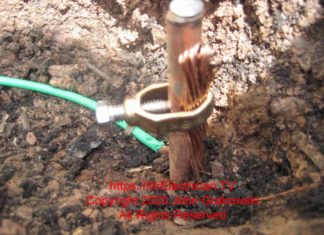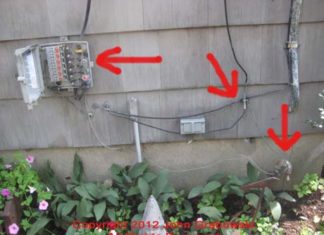Intersystem Bonding Termination
Tag: Intersystem Bonding Termination
Grounding Electrode System
Dear Mr. Electrician: How do I install a grounding rod as part of the grounding electrode system for my house? An electrician told me that the grounding electrode system for my home did not have a good grounding rod and gave me a ballpark price to fix it up. Why do I need this, and what is involved in fixing or installing a grounding rod?
Answer: Keeping the grounding electrode system in your home in good condition is very important. To install a ground rod, some tools and muscles will be needed.
NOTE: Some text links below go to applicable products at EMP Shield or Amazon. As an Amazon Associate, I earn from qualifying purchases. Using my links helps to keep this website FREE.
A ground rod is a critical component of the electrical wiring in your home or place of work. It is part of the grounding electrode system for voltage stabilization and lightning protection. A ground rod is also referred to as a grounding electrode or anode. It is required by article 250.53(D)(2) in the National Electrical Code (NFPA 70).
The power company has its power transformer grounded with at least an eight-foot grounding rod. If the neutral conductor from the transformer to your house ever got disconnected, the returning current would travel through the Earth to return to the transformer.
In addition, when lightning strikes on or around your home or workplace, the rod creates a path for the high voltage electrical charge to go directly to the Earth and avoid causing damage to your home.
Whenever you hear of someone's house getting struck and damaged by lightning, it is usually because the grounding electrode system was deficient.
Table of Contents:
Components of Grounding Electrode System
Upgrading Your Earth Ground
How to Install a Ground Rod
Connecting Other Utilities to Earth Grounding
COMPONENTS OF A GROUNDING ELECTRODE SYSTEM
The grounding electrode system consists of a wire or two originating on the grounding terminal in your main electrical panel or disconnect switch. The wire(s) from the grounding terminal will connect to the home's water pipes and one or more grounding electrodes.
The grounding electrodes can be ground rods, concrete-encased rebar, copper plates, copper wire in the footings, concrete-embedded steel, or other means that provide an approved electrical path to Earth. See article 250.52(A) in the National Electrical Code.
Many houses' primary grounding electrode system connection is at the metal water pipe at the point where it enters the home before the water meter. Look at this area, and you should see a copper or aluminum wire: bare, insulated, metal armor jacketed, enclosed in conduit, or taped green. It should be connected to the water pipe using an approved ground clamp. The connection should be tight and free of corrosion.
The ground clamp in the above photo is attached at the point where the water pipe enters the basement. An armored grounding conductor requires a ground clamp with an extra clamp for the armor to be secured.
If the ground clamp and wire appear corroded or loose, you should remedy this immediately. ...
Grounding TV and Telephone
Dear Mr. Electrician: What can I do about grounding TV and telephone in my house? I want to have good lightning protection. My neighbor was blown out of her chair when lightning hit her TV. How can I prevent that from happening to me?
Answer: Even with a fantastic grounding TV and Telephone, there is no 100% foolproof method of lightning protection or stopping a lightning strike from doing damage.
NOTE: Some text links below go to applicable products on Amazon. As an Amazon Associate, I earn from qualifying purchases. Using my links helps to keep this website FREE.
However, several things can be done to prevent or reduce lightning damage. Everything electrical needs to be properly grounded and bonded in such a manner as to provide a good direct path for lightning to flow to the earth.
An excellent book on the subject of lightning protection installations is NFPA 780.
The photos below depict an actual job of mine correcting the grounding for a 1940s single-family detached house.
Article 250 in the National Electrical Code concerns grounding and bonding. Some relevant sections are 250.8, 250.52, 250.90, 250.94, and 250.104. Also, read article 800.100 on grounding communication circuits and 820.100, which concerns the grounding of cable TV systems.
LIGHTNING PROTECTION FOR POWER, TV, TELEPHONE
The above photo depicts how I found the grounding of the TV and telephone lines. It turns out this pipe was not connected to anything. It was in the ground only a few inches and contained a piece of cut electrical cable, the remains of which protruded from the pipe. This would not be adequate protection if lightning were to strike.
The telephone demarcation point and the cable TV demarcation terminal both need to be bonded to the grounding electrode conductor for the main electrical service. Newer electrical installations have an intersystem bonding termination for connecting the grounding conductor from the telephone and cable TV.
In older houses, the TV and telephone grounding conductors are sometimes connected to an existing ground rod or water pipe, have their own separate ground rod, or are connected to the grounding electrode conductor.
CLICK HERE to See Surge Protection Devices on Amazon
Above was the current cable TV ground connection. I installed a new #10 copper wire and clamped it to the grounding electrode conductor connected to the water pipe inside the house.
The copper wire for grounding the TV and telephone must be no smaller than #10 AWG. #8 wire would probably be too big for most demarcation terminals.
Top Of Page
For adequate grounding of TV and telephone, all interior metal piping must be bonded using water pipe ground clamps with wire jumpers around water meters, water heaters, water softeners, water filters, and other devices whose removal would interrupt ground continuity.
If a section of metal pipe is replaced with plastic pipe, a bonding jumper must be installed to maintain grounding continuity.
The hot and cold metal water pipes must have a jumper between them. This is usually done at the water heater. Although the code requires gas pipes to be bonded, some local...

